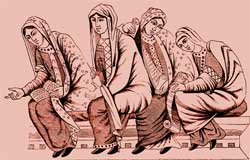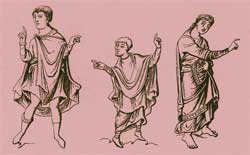Charlemagne
Charles the Great, or, in Latin, Carolus Magnus (probably 742-814), known mostly as Charlemagne (from the combination of the French Charles and the Latin Magnus), has a special place in History, as a legendary symbol of the perfect Medieval King and hero. Beyond the legend, his proven organizational and military skills, his knowledge of the law, helped him in building the first Empire of Medieval Europe.
Charlemagne - The Emperor
Charlemagne was the King of the Franks (768-814). On December 25th A.D. 800, in Saint Peter's Basilica in Rome, Pope Leon III crowned Charlemagne as "Emperor of Romans", the ceremony following the Byzantine rite. When he became King of the Franks in 768, Charlemagne has inherited a divided kingdom. In 800, when Pope Leon III put the Emperor crown on his head, he was ruling over most of Europe, from the Atlantic to the Danube, in what is today Hungary.

Emperor Charlemagne
In 768, when Charlemagne became King, he first ruled together with his brother, Carloman. After Carloman's death in 771, Charlemagne became the one and only ruler of the Franks, whose decaying kingdom was surrounded by an unruly Europe. The Franks were about to return to barbarian ways, while neglecting education and religion, while the Pope was struggling to impose the rules of the Roman Catholic Church in Italy, at that time dominated by the Lombard kingdom.
A man of science and letters, religious and disciplined, Charlemagne decided it's time to put things in order. In 772 he started a long campaign against the Saxons in the north, and, after 30 years, he finally subdued them, and converted them to Christianity. He defeated the Avars, who occupied vast territories along Danube, up to modern day Hungary, and assumed complete control of the rebel Bavaria. In the South, he battled the Saracens, and, on this occasion, one of his minor campaigns became one of the best known. When Charlemagne's army was returning from Spain, the rear guard was attacked by numerically superior Basques at the Roncevaux Pass, and massacred. During the fight, Roland and his friend Olivier, were killed. Their bravery and chivalresque behavior was celebrated in one of the best known chanson de geste, "Le Chanson de Roland".
The Emperor was a great military commander, his campaigns were swift, and his armies moved at amazing speed, Charlemagne's strategy and tactics being at a much later time studied by Napoleon Bonaparte.
Charlemagne - The man
Under Charlemagne, the revival of science and letters, even art and architecture, led to what is known as the "Carolingian Renaissance", which continued under the reign of his son, Louis, who was very learned and skilful in translating and expounding the Holy Scripture.
Charlemagne had created in his palace, under the direction of Alcuin, a sort of academy called the "School of the Palace," which followed him everywhere. The intellectual exercises of this school generally brought together all the members of the imperial family, as well as all the persons of the household.

Ladies of Charlemagne's Court
Charlemagne was one of the most attentive followers of the lessons given by Alcuin. He was indeed the principal interlocutor and discourser at the discussions, which were on all subjects, religious, literary, and philosophical.
Charlemagne took as much pains with the administration of his palace as he did with that of his States. His Capitulaires, a work he wrote on legislature, show that he was interested not only in his warlike and hunting equipages, but also in his kitchen and gardens. He wanted to know, every year, the number of his oxen, horses, and goats; he calculated the revenue from the sale of fruits in his orchards; he had a return of the number of fish caught in his ponds; he pointed out the shrubs best calculated for ornamenting his garden, and the vegetables which were required for his table.
Generally, the Emperor dressed himself as simple as possible. His daily attire consisted of a linen shirt and breeches, and a woolen tunic fastened with a silk belt. Over this tunic he threw a cloak of blue stuff very long behind and before, but very short on each side, leaving his arms free to use his sword. On his feet he wore bands of stuffs of various colors, crossed over one another, and covering his legs also. In winter, when he travelled or hunted on horseback he threw over his shoulders a covering of otter or sheepskin. The change in fashion, which was evolving towards a more luxurious attire, prompted him to issue orders on how his subjects should dress, however, with little effect.
He was keeping his food and drink simple, and pious or historical works were read to him during his repasts. The morning, which began in summer at sunrise, and in winter even earlier, was dedicated to the political administration of his empire. He dined at twelve with his family; the dukes first waited on him, and then took their places at the table, and were waited on in their turn by the counts, prefects, and superior officers of the court. When these had finished, the different chiefs of the household sat down, and they were succeeded lastly by servants of the lower order, who often did not dine till midnight, and had to content themselves with what was left.
When required, however, the Emperor knew how to maintain the pomp and dignity of his rank. But after the event, be that a great religious festival, or receiving ambassadors, he immediately returned to his dear simplicity. The simple tastes of Charlemagne were not always shared by the princes and princesses of his family, nor by the magnates of his court. Poets and historians have described hunts, feasts, and ceremonies, at which a sophisticated splendor was displayed. Eginhard, Charlemagne's faithful servant and biographer, tells us that the sons and daughters of the King were brought up under their father's eye; Charlemagne required his sons to devote themselves to all bodily exercises, such as horsemanship, handling of arms, and his daughters to do needlework and to spin wool. From what is recorded, however, of the frivolous habits and morals of these princesses, it looks like they failed short of meeting their father requirements.

Costumes of Nobility in the time of Charlemagne
The Emperor, usually at war in all parts of Europe, never missed an opportunity of hunting. On such occasions, he was followed by a large number of huntsmen and attendants of his household. He was accompanied by his wife and daughters mounted on magnificent horses, and surrounded by a numerous and elegant court, whose members were displaying their skill and courage in attacking the animals.
The legend says that Aix-la-Chapelle (Aachen in today's Germany), the Capital of the Empire, owes its origin to a hunting adventure of Charlemagne. One day, while chasing a stag, the Emperor had to cross a brook, but immediately his horse had set his foot in the water he pulled it out again and began to limp as if it was hurt. Charlemagne dismounted, and found the foot to be quite hot. When he put his hand into the water, he found it was almost boiling. On that very spot, Charlemagne ordered a chapel to be erected, having the shape of a horse's hoof, and afterwards the town itself was built.
